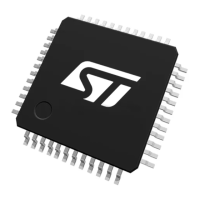Universal serial bus full-speed host/device interface (USB) RM0444
1286/1390 RM0444 Rev 5
USB interrupt status register (USB_ISTR)
Address offset: 0x44
Reset value: 0x0000 0000
This register contains the status of all the interrupt sources permitting application software to
determine which events caused an interrupt request.
The upper part of this register contains single bits, each of them representing a specific
event. These bits are set by the hardware when the related event occurs; if the
corresponding bit in the USB_CNTR register is set, a generic interrupt request is generated.
The interrupt routine, examining each bit, performs all necessary actions, and finally it clears
the serviced bits. If any of them is not cleared, the interrupt is considered to be still pending,
and the interrupt line is kept high again. If several bits are set simultaneously, only a single
interrupt is generated.
Endpoint/channel transaction completion can be handled in a different way to reduce
interrupt response latency. The CTR bit is set by the hardware as soon as an
endpoint/channel successfully completes a transaction, generating a generic interrupt
request if the corresponding bit in USB_CNTR is set. An endpoint/channel dedicated
interrupt condition is activated independently from the CTRM bit in the USB_CNTR register.
Both interrupt conditions remain active until software clears the pending bit in the
corresponding USB_CHEPnR register (the CTR bit is actually a read only bit). For endpoint-
/channel-related interrupts, the software can use the direction of transaction (DIR) and IDN
read-only bits to identify which endpoint/channel made the last interrupt request and called
the corresponding interrupt service routine.
The user can choose the relative priority of simultaneously pending USB_ISTR events by
specifying the order in which software checks USB_ISTR bits in an interrupt service routine.
Only the bits related to events, which are serviced, are cleared. At the end of the service
routine, another interrupt is requested, to service the remaining conditions.
Bit 1 PDWN: Power down
This bit is used to completely switch off all USB-related analog parts if it is required to
completely disable the USB peripheral for any reason. When this bit is set, the USB
peripheral is disconnected from the transceivers and it cannot be used.
0: Exit power down.
1: Enter power down mode.
Bit 0 USBRST: USB Reset
– Condition: Device mode
Software can set this bit to reset the USB core, exactly as it happens when receiving a
RESET signaling on the USB.The USB peripheral, in response to a RESET, resets its
internal protocol state machine. Reception and transmission are disabled until the
RST_DCON bit is cleared. All configuration registers do not reset: the microcontroller must
explicitly clear these registers (this is to ensure that the RST_DCON interrupt can be safely
delivered, and any transaction immediately followed by a RESET can be completed). The
function address and endpoint registers are reset by an USB reset event.
0: No effect
1: USB core is under reset
– Condition: Host mode
Software sets this bit to drive USB reset state on the bus and initialize the device. USB reset
terminates as soon as this bit is cleared by software.
0: No effect
1: USB reset driven

